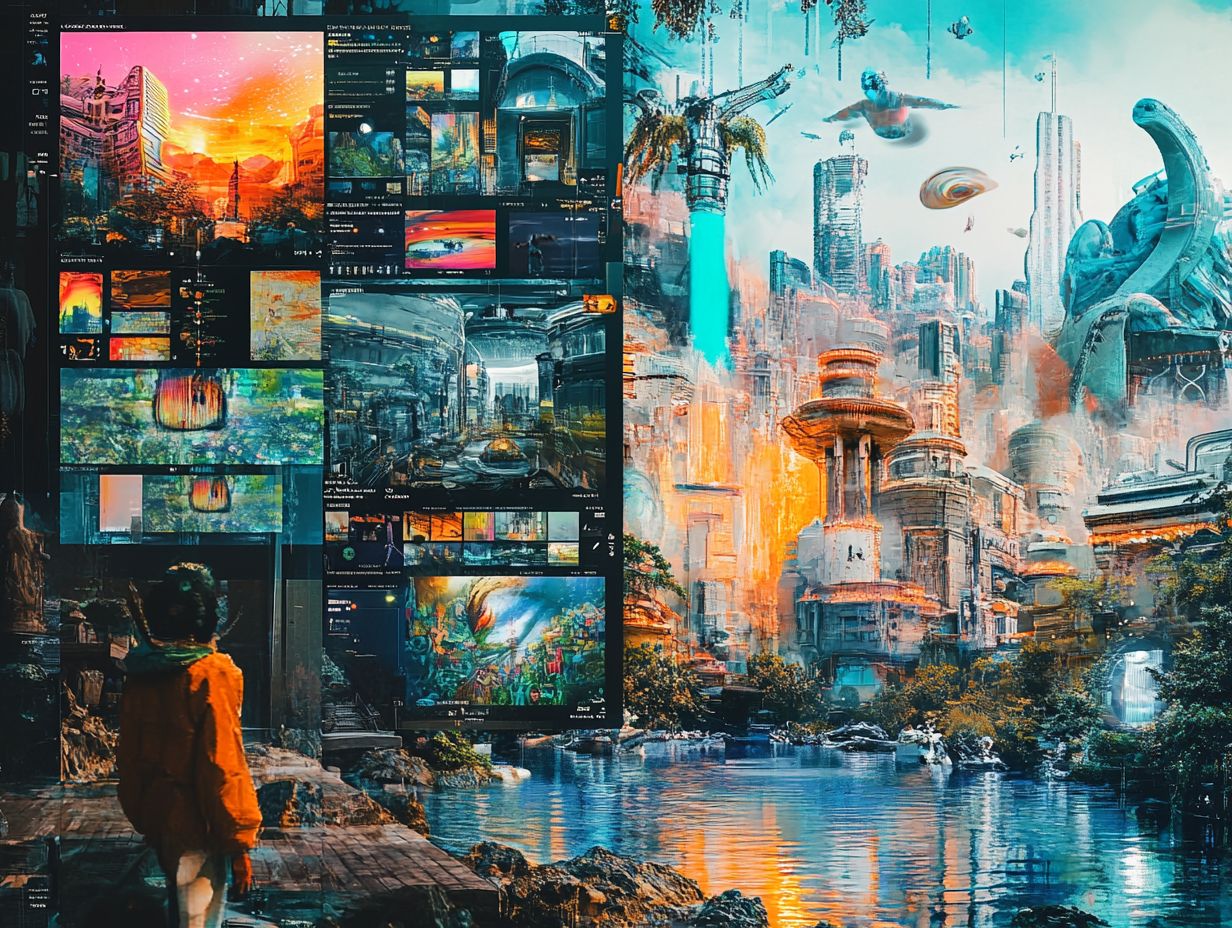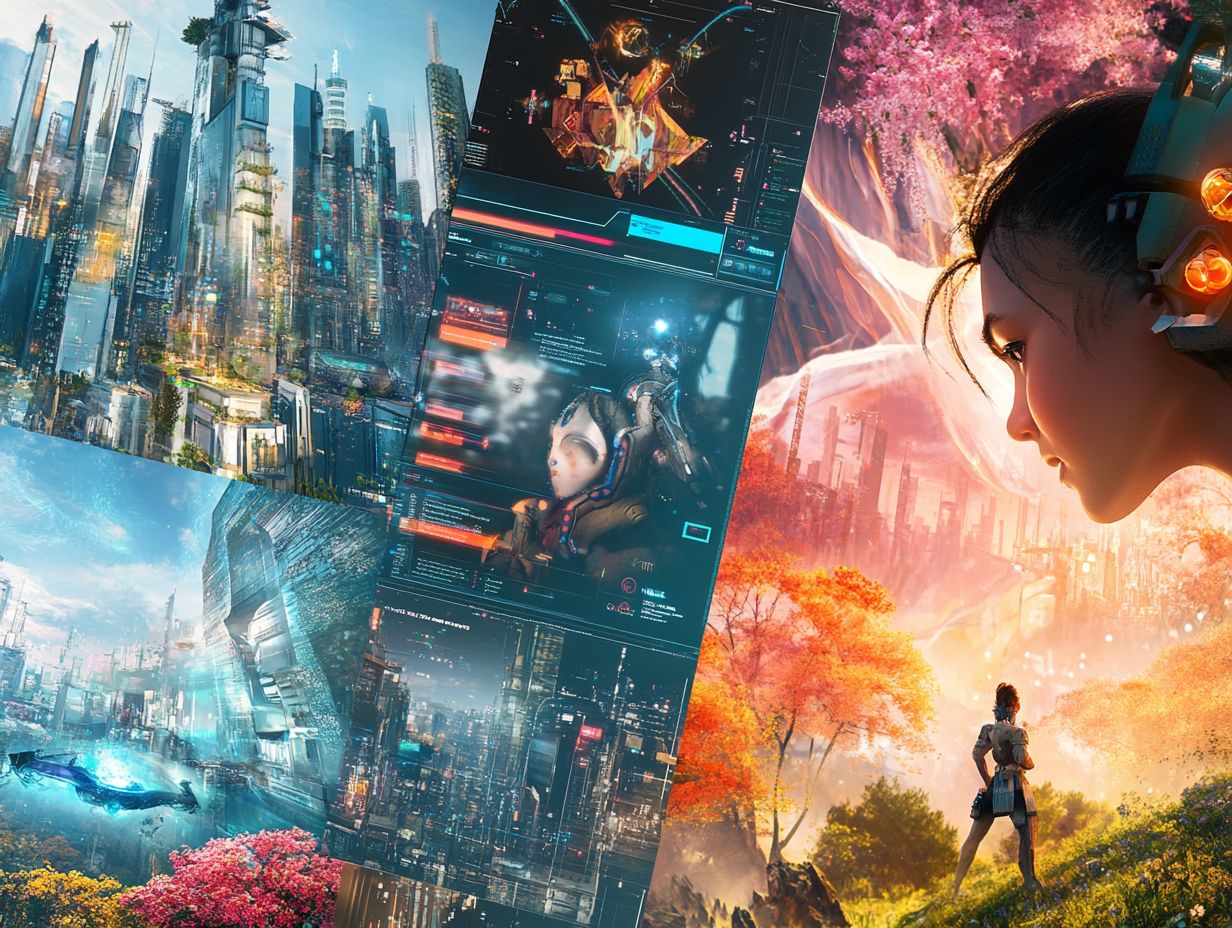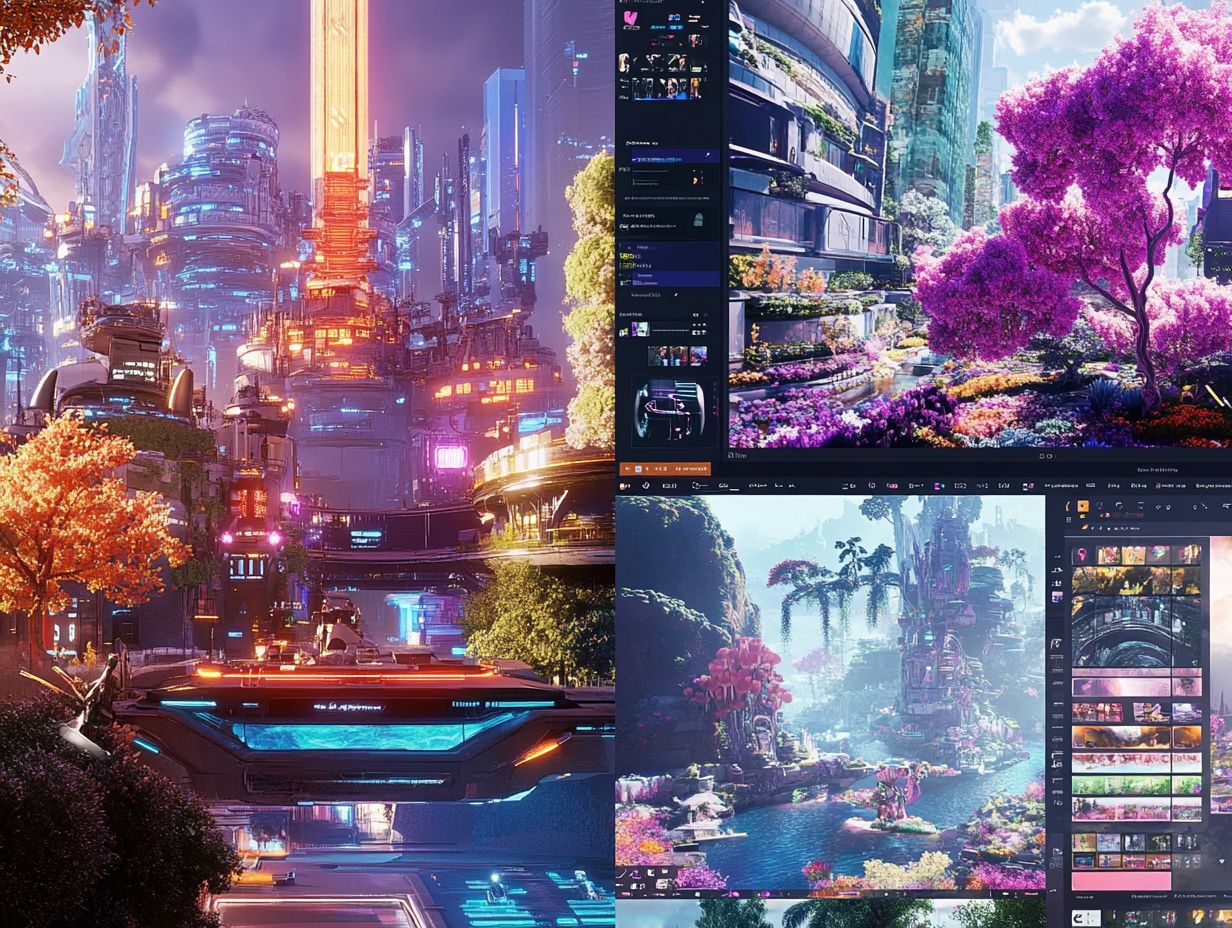Image generators have fundamentally transformed the way I create visual content, making the process more efficient and accessible for a wide range of users, from artists to marketers.
In this article, I delve into what AI image generators are and outline their numerous advantages, including efficiency, versatility, and cost-effectiveness. I offer an overview of popular tools available in the market, key factors to consider when selecting the right generator, and a step-by-step guide on how to effectively utilize these innovative tools.
Furthermore, I provide tips and best practices designed to help maximize results. I invite you to explore how these tools can significantly enhance your creative projects.
What are AI Image Generators and Their Application Areas?

AI image generators represent a remarkable advancement in image generation technology, utilizing artificial intelligence and deep learning to produce stunning visual content from textual descriptions. This capability enables both professional artists and hobbyists to delve into the world of digital art.
These sophisticated systems employ machine learning and neural networks, including generative adversarial networks (GANs), to synthesize images that align with user-defined parameters, transforming simple words into intricate designs and high-resolution visuals. Prominent AI image generators such as DALL-E, Midjourney, and Stable Diffusion showcase the forefront of graphics technology and image synthesis, catering to a diverse array of artistic needs and creative workflows.
By analyzing extensive datasets and learning from numerous examples, these models capture the nuances of styles, colors, and compositions, allowing them to create digital artwork that can truly impress experienced creators.
The versatility of these tools extends well beyond personal projects; they are increasingly utilized in advertising, game development, and animation, where they enhance the creative process and introduce innovative ideas.
As user-generated content continues to expand, both amateurs and professionals are leveraging the power of AI image generators, pushing the boundaries of traditional art and redefining the collaboration between humans and machines in the creative landscape.
Benefits of Using AI Image Generators for Creative AI
The benefits of using AI image generators are numerous, significantly enhancing my creative process as an artist and designer by offering efficiency and versatility in producing digital illustrations through enhanced prompt engineering.
These tools not only save valuable time but also provide exceptional levels of customization, allowing me to explore a wide range of art styles and create automated artwork.
By leveraging the power of AI creativity and real-time rendering, I can generate realistic images and artistic expressions that would typically take hours or even days to create using traditional methods.
This capability is revolutionizing the landscape of visual storytelling and expanding the possibilities for artistic expression.
Efficiency, Versatility, and Scalability
AI image generators provide me with remarkable efficiency, versatility, and scalability in the creative process, enabling me to produce high-quality visuals in a fraction of the time it would typically require. By leveraging advanced algorithms and deep learning techniques, these tools allow me to experiment with various design options and art styles, ultimately enhancing my creative workflow.
This efficiency not only accelerates project timelines but also opens the door for more experimentation and exploration in artistic expression, making it an invaluable resource for both seasoned professionals and emerging creatives.
For example, as a graphic designer, I can quickly generate multiple concept illustrations based on a single prompt, significantly reducing the time I spend on initial drafts and enhancing user-generated content. I might also utilize these generators to envision unique edits or enhancements for my photographs before diving into software, while illustrators can draw inspiration from the diverse styles that this technology offers.
This level of versatility fosters my creativity and encourages me to step outside my comfort zone, trying techniques I may not have explored otherwise. Consequently, as the creative landscape evolves, these tools become essential in making my artistic creation more efficient and flexible.
Cost-Effectiveness and Accessibility

One significant advantage I see in AI image generators is their cost-effectiveness, especially for businesses and individual creators aiming to produce digital art without the burden of extensive resources or high overhead costs.
By utilizing these automated tools, I can minimize expenses typically associated with traditional art production methods, such as hiring artists or investing in expensive design software, while benefiting from online platforms offering subscription models. This democratization of art creation not only fosters greater innovation but also opens doors for user-generated content while simplifying licensing issues and usage rights for various projects.
With AI-generated visuals, I can quickly produce high-quality images on demand, significantly reducing both time and financial investments. This shift allows me, whether I’m part of a startup or a seasoned professional, to allocate my budget more efficiently, directing funds toward marketing or other essential aspects of my business.
The ease of use associated with these tools enables a broader range of individuals, regardless of their artistic background, to engage in creative pursuits. As usage rights become clearer through structured licensing, I can confidently share and monetize my works, enhancing my revenue potential without the challenges associated with traditional art creation.
Popular AI Image Generators on the Market and Cross-Platform Capabilities
I have observed a significant surge in the popularity of AI image generators in the market, with prominent platforms such as DALL-E, Midjourney, and Stable Diffusion at the forefront of image generation technology.
These platforms utilize advanced generative models and neural networks to produce impressive visuals, each presenting unique features and capabilities designed to cater to diverse user requirements, including cross-platform capabilities and API access.
As I engage with these AI tools, I find that they greatly enhance my artistic expression, offering endless possibilities for digital art and multimedia storytelling.
Overview of Top Choices and their User Interface
In my exploration of the leading AI image generators, I have come to appreciate a competitive landscape where tools like DALL-E, Midjourney, and Stable Diffusion distinguish themselves through their image generation capabilities and intuitive user interface.
Each of these AI tools offers unique strengths that cater to various artistic needs and preferences while fostering a sense of community among users.
From generating realistic images to crafting abstract art, these platforms provide a comprehensive user experience and significantly contribute to the evolving field of creative AI.
As I delve into the distinct features of these generators, I find that DALL-E excels in producing detailed and imaginative visuals, often infused with humor and creativity.
Midjourney, on the other hand, is renowned for its ability to create ethereal landscapes and dream-like scenes, appealing particularly to those with a penchant for fantasy.
Meanwhile, Stable Diffusion allows users to explore a myriad of artistic styles, seamlessly adapting to personal expression.
The strength of community sharing is particularly noteworthy, as it inspires creators by enabling them to learn from each other’s techniques, share modifications, and collaborate in ways that enhance the creative potential of these advanced tools, supported by community feedback and user reviews.
Factors to Consider when Choosing an AI Image Generator and Ensuring Compatibility

When selecting an AI image generator, I consider several key factors to ensure I choose the right tool for my creative needs, including features, functionality, pricing structures, and compatibility with existing software tools.
Understanding the capabilities of various AI tools and how they align with my artistic goals is essential for enhancing my design automation processes.
Additionally, I take into account user reviews and community feedback, as they provide valuable insights into the performance benchmarks and overall experience of using specific platforms.
This thorough approach guides me toward making the best choice for my projects.
Features, Functionality, and Style Transfer
The features and functionality of AI image generators play a crucial role in determining their usability and effectiveness in the creative process. I find that customization options, output formats, and style transfer capabilities are key considerations in my choice of tools.
Many users, including myself, appreciate platforms that offer a broad range of options, allowing us to tailor our image generation experience to meet specific artistic needs and styles. By utilizing advanced algorithms and deep learning, these tools can produce diverse outputs, making adaptability essential for anyone interested in creating digital art and automated visuals with high-resolution images.
These generators not only provide sleek customization but also support multiple output formats, catering to the varied needs of artists, designers, and marketers. I have the freedom to select image resolutions or styles that best suit my projects, which fosters a more immersive and satisfying creative process.
The ongoing advancements in technology ensure that the quality of the images produced is higher than ever, with intricate details and vivid colors greatly enhancing the overall visual experience.
As a result, engaging with these innovative tools has streamlined my workflow, inspiring greater creativity and exploration within my artistic endeavors.
Pricing, User Reviews, and Ethical Considerations
When evaluating different AI image generators, I find that pricing, user reviews, and ethical considerations are crucial elements to consider, as they provide valuable insights into the value and performance of various software applications available in the market.
By understanding the pricing models of popular AI image generators like DALL-E and Stable Diffusion, I can make informed decisions that align with my budget and specific needs. User feedback is particularly illuminating, as it highlights actual performance benchmarks and helps me assess the effectiveness of the image generation capabilities of these platforms.
I have noticed that different AI image generators, including free versions, offer various pricing structures, including subscription models that grant ongoing access to updates, API access, and features, as well as one-time fees for permanent ownership of the software. My choice between these models typically reflects my individual preferences and usage frequency.
User reviews play a pivotal role in my decision-making process; they often share experiences that reveal both the strengths and weaknesses of different tools, providing me with a clearer picture of what to expect in terms of image quality, originality, and user engagement.
By analyzing market trends alongside user feedback, I can significantly enhance my selection process, ensuring that I choose an AI image generator that meets my expectations, aligns with industry standards, and delivers true value.
How to Use an AI Image Generator for Creative AI

To effectively utilize an AI image generator, I focus on familiarizing myself with the software’s user interface and understanding the step-by-step processes required for generating images with computer vision techniques.
While the ease of use can vary across different platforms, most offer intuitive design interfaces that enable me to input data and customize outputs without requiring extensive technical expertise.
By mastering these fundamental aspects, I can significantly enhance my creative workflows and project collaboration, leveraging AI tools to produce compelling visual content tailored to my specific needs, especially in branding and social media.
Step-by-Step Guide for Generative Design
This step-by-step guide will assist me in navigating the essential processes of using an AI image generator, covering everything from data input to generating high-quality images with unique styles, while considering usage rights and community guidelines.
Initially, I need to input descriptive text that will guide the AI in creating images, ranging from simple phrases to detailed descriptions, thereby enhancing the text-to-image capabilities of the tool. Once the images are generated, I can preview them, make any necessary adjustments, and finally save or share my creations, all while ensuring compliance with licensing considerations and avoiding copyright issues.
To achieve the best results, it is crucial for me to experiment with varying levels of detail in my prompts and familiarize myself with the specific features of the AI image generator I am using. Many platforms also provide options to customize elements such as styles or color palettes, which can significantly influence the final output and increase output diversity.
Additionally, understanding and adhering to community guidelines is equally important, as it ensures respectful and appropriate use of the generated images. I should carefully review the usage rights associated with my creations, especially if I plan to utilize the images commercially, to avoid potential legal issues and to celebrate creativity responsibly through creative AI.
Tips for Maximizing Results with AI Image Generators Using Creativity Tools
Maximizing results with AI image generators requires me to implement best practices and techniques that enhance both the visual aesthetics and image quality of the generated images.
By understanding the strengths and limitations of the AI tools I have at my disposal, such as midjourney and generative adversarial networks (GANs), I can tailor my input and refine my creative process to achieve the desired outcomes.
Incorporating elements such as detailed descriptions, specific art styles, and thoughtful editing allows me to elevate my projects, ensuring that the images produced closely align with my artistic vision and enhance visual content creation.
Best Practices and Techniques for Visual Effects
Employing best practices and techniques when using AI image generators can profoundly enhance the quality of the visual content I produce, encompassing both image manipulation and artistic expression, and leading to photo realism.
I focus on crafting detailed and specific prompts, as these significantly influence the output quality and relevance of the images, thus inspiring design inspiration and future developments.
By experimenting with various art styles and customization options, I can achieve unique and engaging results that enrich the creative process and increase my overall satisfaction with the generated artwork, while adhering to technology trends.
To maximize the potential of AI image generation, I explore different combinations of keywords and descriptive phrases that effectively capture the essence of the desired artwork. This often involves adjusting parameters such as color palettes, textures, and emotional tones that resonate with my intended audience, considering competitive analysis.
I understand the power of iteration; by refining prompts and incorporating feedback, I can enhance the quality of my results. Keeping an open mind and embracing creativity greatly enriches my artistic experience, often leading to unexpected and delightful surprises along the way, supported by research papers and community support.
